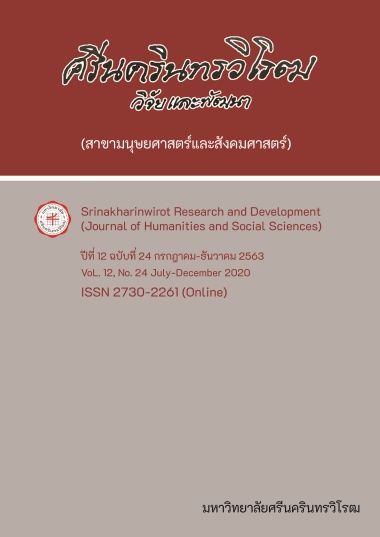ความรู้และพฤติกรรมการจัดการซากบรรจุภัณฑ์สารเคมีกำจัดศัตรูพืชของเกษตรกร ผู้ปลูกผัก ตำบลขี้เหล็ก อำเภอเมือง จังหวัดอุบลราชธานี KNOWLEDGE AND BEHAVIOR CONCERNING PESTICIDE PACKAGING WASTE MANAGEMENT OF VEGETABLE GROWERS IN KHI LEK SUBDISTRICT, MUEANG DISTRICT, UBON RATCHATHANI PROVINCE
Keywords:
Behavior, Knowledge, Packaging Waste Management, Pesticides, Vegetable GrowersAbstract
This cross-sectional research aims to study the knowledge and behavior concerning pesticide packaging waste management among vegetable growers in Khi Lek Subdistrict, Mueang District, Ubon Ratchathani Province. The questionnaire was collected from 103 vegetable growers by accidental sampling method. Data were analyzed using frequency count and percentages. The study found that the most common type of pesticide packaging found in this area was glass bottles (90.29%). The vegetable growers’ knowledge of pesticide packaging waste management was good (93.20%). Their behavior toward pesticide packaging waste management was at the improvable level, 93.20%. Their improper practices included the disposal of pesticide packaging waste into municipal bins (28.16%), the lack of engagement in separating pesticide packaging waste from other wastes (16.51%), and the selling of pesticide packaging waste to junk shops (14.57%). This study found that the vegetable growers did not do the following: putting up a warning sign at the landfill (57.14%), destroying pesticide packaging waste (46.75%), sprinkling lime when depositing pesticide containers in the landfill (41.55%), and putting lime in the dump pit (40.26%). Therefore, the concerned agencies should promote positive behaviors toward pesticide packaging waste management for vegetable growers to reduce the impacts of pesticides on human health and the environment.
Downloads
References
[2] Office of Disease Prevention and Control 10. (2017). Operations, development, disease prevention and control together with Ubon Ratchathani Province, fiscal year 2017. Retrieved from https://odpc10.ddc.moph.go.th/wp-content/uploads/2018/01/20180117083837.pdf
[3] Md. Wasim Aktar, Dwaipayan Sengupta, & Ashim Chowdhury. (2009). Impact of pesticides use in agriculture: their benefits and hazards. Interdisc Toxicol, 2(1), 1-12.
[4] Brenda Eskenazi, Asa Bradman, & Rosemary Castorina.(1999). Exposures of Children to Organophosphate Pesticides and Their Potential Adverse Health Effects. Center for Children's Environmental Health Research, School of Public Health, University of California Berkeley California, USA. Retrieved from https://ehp.niehs.nih.gov/doi/pdf/10.1289/ehp.99107s3409
[5] Department of Environment Quality Promotion, Ministry of Natural Resources and Environment. (2013). The pesticides packaging waste management in Thailand. Retrieved from http://doc4.clib.psu.ac.th/public31/research/384609-abs.pdf
[6] Nong Tae Health Promoting Hospital. (2017). Annual Report, Nong Tae Health Promoting Hospital. Mueang District, Ubon Ratchathani Province.
[7] Department of Environment Quality Promotion, Ministry of Natural Resources and Environment. (2017). The National waste management master plan (2016-2021). Retrieved from http://www.parliament.go.th
[8] Chiraporn Lapkham, Chonthicha Pongjit, & Tippawan Petrawes (2016). Agricultural chemicals packaging behavior management of farmer's in Ban Kaset Pattana Nuea and Ban Kaset Samakki, Kham Khwang Sub-district, Warinchamrap District, Ubon Ratchathani Province. Science and Technology Journal, Ubon Ratchathani University, 18(2), 11-21.
[9] Lemeshow S, Hosmer DW, Klar J, Lwanga SK. (1990). Adequacy of sample size in health studies. 1st ed. Chichester: John Wiley & Sons.
[10] Christos A. Damalas, & Ilias G. Eleftherohorinos. (2011). Pesticides Exposure, Safety Issues, and Risk Assessment Indicators. Int. J. Environ. Res. Public Health, 8, 1402-1419.
[11] Mariam T. Al Hattab, & Abdel E. Ghaly. (2012). Disposal and Treatment Methods for Pesticide Containing Wastewaters: Critical Review and Comparative Analysis. Journal of Environmental Protection, 3, 431-453.
[12] Apiwat Tawatsin, Usavadee Thavara, & Padet Siriyasatien. (2015). Pesticides used in Thailand and toxic effects to human health. Medical Research Archives, 3, 1-10.
[13] Pollution Control Department. (2017). Chemical and Hazardous waste. Retrieved from http://www.pcd.go.th/Info_serv/haz_chemicals_use.html
Downloads
Published
How to Cite
Issue
Section
License
Srinakharinwirot Research and Development Journal of Humanities and Social Sciences is licensed Under a Creative Commons Attribution-NonCommercial-NoDerivs 4.0 International (CC-BY-NC-ND 4.0) License, Unless Otherwise Stated. Please Read Journal Policies Page for More Information on Open Access, Copyright and Permissions.



